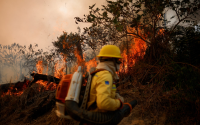10 April 2006
They are the human shields. Every time there is the sound of sabre-rattling from the West over Iran's suspected nuclear weapons programme, the protesters are back in the picture.
Some have been deployed in a human chain outside sensitive sites in remote areas of Iran. Others rally outside the embassies of the United States and Britain in Tehran.
In the West, public opinion is hardening against the prospect of a nuclear-armed Islamic republic. Inside Iran, the public has been galvanised by its leaders into mobilising in support of the country's nuclear programme.
The Iranian demonstrators are likely to be needed again in the light of a shock report by the authoritative journalist Seymour Hersh that the Bush administration is considering possible strikes by tactical "bunker-buster'' nuclear missiles able to destroy facilities deep underground.
According to his article in The New Yorker, the plans aimed at engineering regime change in Tehran have split the Pentagon top brass to such an extent that some officers have threatened to resign their posts.
Jack Straw, the Foreign Secretary, yesterday dismissed the claim of a nuclear strike being used to prevent Iran from obtaining its own atomic weapon as "completely nuts". The Iranians described the article as the part of the "psychological war" launched by the US to frighten Tehran into abandoning what it believes is its treaty right to develop nuclear technology.
But President George Bush has been careful to keep the military option on the table throughout the stand-off with Iran over its nuclear programme, which intensified last June with the election of President Mahmoud Ahmadinejad.
Mr Ahmadinejad, a former member of the fanatical Revolutionary Guards, set alarm bells ringing throughout the West - and even in his own country - by threatening to "wipe Israel off the map".
Even though it is the country's spiritual leader, the Ayatollah Ali Khamenei, who calls the shots in Iran, according to The New Yorker, it is Mr Bush's deep distrust of Mr Ahmadinejad that has strengthened his determination to confront Iran.
But time is running out. Diplomatic moves are at a standstill because of the reluctance from Russia and China to impose sanctions against Iran, which has important support from developing countries where nuclear power is seen as a legitimate right.
In the West, arms control experts - as well as European governments - are convinced that Iran wants to pursue uranium enrichment at its underground facility at Natanz with the intention of keeping open the option of building a bomb. The difference between enriched uranium for a nuclear power plant and for a weapon lies in the level of enrichment. Fuel for a civilian reactor requires 2 to 3 per cent uranium-235, while a nuclear bomb needs 90 per cent or more, a range known as highly enriched uranium.
The Iranians will have mastered the technology that can allow its centrifuges to enrich uranium without exploding or breaking down in a matter of months, according to Western experts. When that happens, the world will be hurtling towards a nuclear nightmare. Israel's arch foe will have obtained a powerful tool with which to threaten its neighbours.
Estimates vary as to how long it would take Iran to reach the break-out capability. The generally cautious director general of the International Atomic Energy Agency (IAEA), Mohamed ElBaradei, who is to visit Iran this week, believes that it could take up to two years for Natanz to be up and running. At that point, he says, an Iranian nuclear bomb could be "a few months away".
The estimate of the Egyptian IAEA chief echoes Israeli thinking. United States estimates range from five to 10 years for weapons-grade fuel to be successfully manufactured.
According to a study by the International Institute for Strategic Studies, with 1,000 working centrifuges at Natanz, it would take just over two years to produce enough highly enriched uranium for a bomb - without the IAEA safeguards which are currently in place. With 3,000 centrifuges, the number Iran has told the Europeans it wants to install at Natanz, it would take 271 days to produce the same amount of weapons-grade fuel. According to one expert, such a fuel cycle would be a clear indication that the Iranians are bent on building a bomb.
There are two ways of making a nuclear bomb: a relatively simple way which results in a plutonium bomb and a harder way using enriched uranium. But whichever route is followed, step one in making the fuel for a nuclear bomb - or a civilian reactor - is to mine uranium.
In step two, the uranium ore is ground into a powder and reconstituted into a solid known as yellowcake, which is radioactive. Step three involves the conversion of yellowcake into uranium hexafluoride gas.
In step four, the gas is fed into centrifuges, measuring one and a half metres tall, where the uranium enrichment takes place. This process increases the percentage of uranium-235 to the levels needed to be used as fuel in a civilian reactor, or a weapon, by separating the uranium isotopes in the rapidly spinning rotor tubes.
But there are well known problems with gas centrifuges. If they do not operate in a vacuum, rust and corrosion sets in. The spinning at enormous speeds can cause uncontrollable vibrations which can send shrapnel flying and cause explosions. The Iranians lost one third of their centrifuges when they agreed to halt uranium enrichment in November 2003 under an agreement with the European Union. That agreement was shattered last January when Iran reopened Natanz, where it tested an array of 20 centrifuges in vacuum conditions.
The method involving plutonium has a clear advantage because it needs much smaller quantities - 4kg rather than the 25kg of enriched uranium required to produce a bomb. Plutonium does not exist in a natural state, and is the product of reprocessed spent reactor fuel, after yellowcake has been reduced to uranium metal.
The extraction of plutonium is a serious engineering challenge as spent fuel is highly radioactive and toxic, and a very dangerous process.
The main worry for the West is that Iran has dabbled in all aspects of the nuclear fuel cycle, on both the enriched uranium route and the plutonium route.
It has a uranium mine, it has a conversion facility just outside the city of Isfahan, which was reopened last summer in violation of its agreement with the European Union, and it has the Natanz enrichment plant.
Although work has been suspended at Arak, 150 miles south of Tehran, Iran is in the early stages of constructing a heavy water plant that is to supply a research reactor which could eventually produce enough weapons-grade plutonium for one or two weapons per year.
Although nuclear experts say that the international community has been distracted by the crisis triggered over Iran's uranium enrichment programme, the plutonium experiments have the potential for creating a far more worrying situation. "With uranium, it's much easier to put in safeguards to monitor the atmosphere and instruments," said Paul Ingram, a senior analyst with the British American Security Information Council, which specialises in nuclear issues.
Nuclear reprocessing is more difficult for inspectors to verify, in terms of possible diversion for military purposes. And reprocessing can take place in a very small area. "It could be done in a plant the size of a house, in the middle of a mountain," if Iran decided to carry on with a clandestine programme, Mr Ingram said. "If the Iranians succeed in producing a heavy-water plant plus a reactor at Arak, then we are in a very difficult situation."
The Russians are helping Iran build a "safe" light-water reactor at Bushehr in the south of the country. Under an agreement with the Russians, the fuel rods for the reactor, which has not yet come on stream, are to come from Russia and will be sent back there for reprocessing to avoid any possible diversion.
The main nuclear powers, including Britain, followed the reprocessing route to build their modern arsenal. The US, in the early days, experimented with the fuel cycle of both enriched uranium and plutonium: the bomb that flattened Hiroshima in August 1945 was a uranium bomb, while the bomb that blasted Nagasaki three days later was plutonium.
Iraq went down the centrifuge route, although after 10 years of efforts, Saddam Hussein had still not produced a weapon when the UN inspectors belatedly discovered, and dismantled, its clandestine programme in the 1990s.
Pakistan also took the enrichment route, most probably because the father of the Muslim world's atom bomb, AQ Khan, worked in the 1970s for a Dutch uranium enrichment plant, Urenco, which supplied European reactors. He used a centrifuge design stolen from Urenco to build facilities in Pakistan for weapons-grade uranium.
So why did Iran decide to put its major effort into travelling along the bumpy road towards uranium enrichment?
In fact the Iranians were following both routes from the beginning. They bought their first nuclear reactor from the US, during the rule of the Shah. But the breakthrough came in the 1980s when Iran bought a blueprint for a P1 centrifuge from the AQ Khan network, which operated like a nuclear supermarket.
United Nations inspectors with the IAEA are still trying to unravel the history of Iran's nuclear know-how and have not proved without a doubt that the Iranians are working on a bomb.
Iran is meanwhile being asked by the UN Security Council to suspend all uranium enrichment work. Tehran has refused.
In the next few weeks, the West will have to decide what carrot, or what stick, to use next.
"In terms of strategy, the West needs to think more clearly about the need to work with the Iranians and the IAEA to keep the inspectors inside Iran. The key to all this is to ensure the IAEA is on the ground and with the Iranians co-operating," said Mr Ingram.
http://news.independent.co.uk/world/middle_east/article356854.ece






